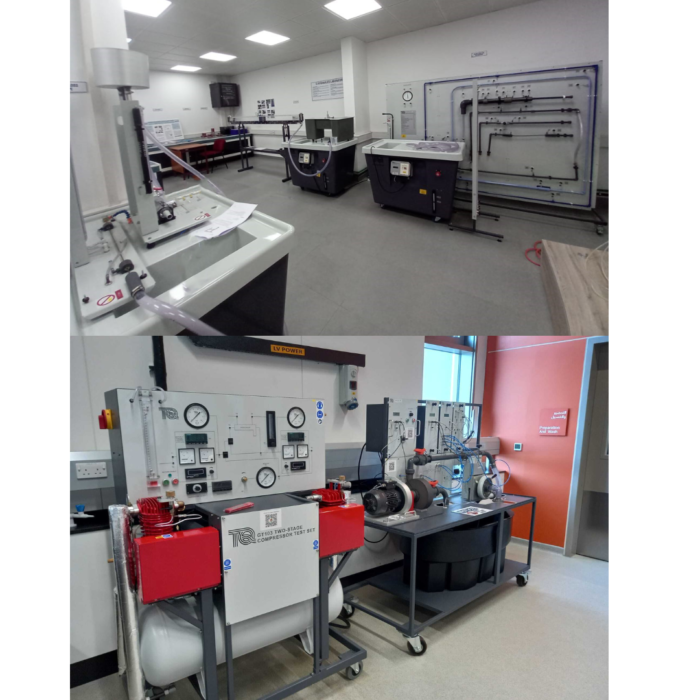The Versatility of Scaled Wind Tunnels
Wind tunnels are not confined to aerospace alone; they play a pivotal role in numerous engineering fields. From civil engineering to renewable energy, agricultural to architectural, and automotive design to environmental engineering, wind tunnels enable students to explore the science of aerodynamics in controlled environments, observing and analysing the effects of airflow or gases around different structures and objects, whether stationary or in motion. This hands-on experience is crucial in helping students understand complex theories and principles of aerodynamics in a practical context and aids designers and engineers in improving durability, safety, and efficiency across a range of applications.
Types of Wind Tunnels and Their Features:
Wind tunnels come in a range of sizes, from compact benchtop models to large-scale research-grade systems. They can be subsonic or supersonic and are available as closed-circuit or open-circuit designs. The transparent working sections in many tunnels allow students to visually observe the aerodynamic phenomena, making the learning experience more engaging. The integration of advanced tools, such as smoke generators and sensors, enhances the visualisation of airflow and enables precise measurements, fostering a deeper understanding of aerodynamics and flow behaviour.
Exploring Reynolds Number and Atmospheric Boundary Layers:
One of the unique advantages of wind tunnel testing lies in the ability to manipulate the Reynolds number to model real-world conditions. This is especially useful when comparing flow conditions to the atmospheric boundary layer, helping students and researchers explore critical aerodynamic effects with precision and relevance to real-world scenarios.
Applications Across Engineering Disciplines:
- Aerospace Engineering: for studying aircraft performance, stability, and control. By experimenting with different wing shapes and angles, students can witness first-hand how lift, drag, and other specific aerodynamic variables such as pitch, yaw, roll interact, deepening their understanding of flight mechanics and performance. For more advanced studies, custom made models and experiments can be used inside wind tunnels to expand further into more advanced aerodynamic concepts.
- Civil Engineering: for studying structural engineering, particularly for the design of tall buildings, stadiums, bridges, and other structures. Students can simulate wind effects on scale models, observing how different designs respond to various wind speeds and crosswind excitation, as well as simulate the impact at pedestrian level. This practical application is vital for ensuring safety and building stability in real-world property developments. This is further beneficial to institutions wishing to study weather conditions such as hurricanes, earthquakes and tornados and their behaviour around buildings so they can test adaptive design solutions.
- Automotive Engineering: In automotive design, wind tunnels are used to test the aerodynamics of scale model vehicles. Students can learn how to reduce drag to improve fuel efficiency and road performance, and enhance vehicle stability through wind tunnel testing, gaining invaluable experience for careers in automotive engineering.
- Renewable Energy Engineering: crucial for studying wind turbine performance. By exploring underlying mechanisms of wind turbines induced flow and testing different turbine designs and placements, students can learn to understand the complexities of wind energy such as how to design turbines to maximise energy efficiency and ensure durability in harsh conditions. Particularly relevant with the world investing in sustainable energy solutions such as determining wind farm layout and placement for maximum power generation.
- Environmental Engineering: Wind tunnels can simulate environmental conditions, allowing students to study atmospheric boundary layer as well as the dispersion of pollutants in the air. This application is vital in developing strategies to reduce air pollution and improve public health.
- Design and Manufacturing Engineering: wind tunnels offer unparalleled opportunities for exploring and optimising design concepts. For example, in competitive cycling, aerodynamics plays a pivotal role in performance, so understanding and optimising bike, helmet and clothing material designs make it a valuable testing apparatus.
Scale Model Wind Tunnel Testing, Key Advantages
Wind tunnel testing delivers a range of advantages that make it an invaluable tool in both educational and professional contexts:
- Accurate Results: Wind tunnels provide precise and reliable data, reducing the need for assumptions in calculations and modelling.
- Innovation Opportunities: Testing with wind tunnels allows for creative design solutions such as architectural expression that would not be otherwise possible.
- Cost Savings: By accurately predicting how structures will respond to wind forces, wind tunnel testing can lead to significant construction savings.
- Regulatory Compliance: Wind tunnel testing is often recommended by building legislation to ensure safety and can provide increased litigation protection.
Elevating Engineering Education: Case Studies
Wind tunnel applications can vary due to the nature of their versatility. Here are a handful of customers that have invested in our wind tunnels:
Kent State University, USA, Applied fluid dynamics course, Milton Keynes College, UK, Mechanical Principles and Applications module, Al-Farahidi University, Iraq, Aeronautical Engineering Course.
Read some more applications of our wind tunnels from around the world:
Universidad Ricardo Palma and TecQuipment’s AF1600S Subsonic Wind Tunnel
Universidad Ricardo Palma in Lima, Peru, has introduced TecQuipment’s AF1600S Subsonic Wind Tunnel into its architecture curriculum. The wind tunnel now supports architectural students in testing their design concepts and scale models, providing them with practical insights into the effects of wind on building structures. Students can simulate various wind conditions, analyse the aerodynamic performance of their designs, and validate the choice of materials, bridging the gap between theoretical knowledge and practical application.
Fareham College’s CEMAST and TecQuipment’s Subsonic Wind Tunnel
Fareham College (CEMAST) centre is a cutting-edge UK student engineering facility that houses a TecQuipment Subsonic Wind Tunnel (AF1300), allowing students to gain a comprehensive understanding of aerodynamics and engineering principles. Used alongside decommissioned aircraft and helicopters the wind tunnel lets students explore various aerodynamic concepts such as flow past bluff and streamlined bodies, boundary layer development, and the influence of aspect ratio on aerofoil performance. These hands-on investigations help students bridge the gap between theoretical knowledge and practical application, enhancing their educational outcomes and preparing them for real-world engineering challenges.
Nazarbayev University and the AF1600S Subsonic Wind Tunnel
Nazarbayev University in Kazakhstan has integrated TecQuipment’s AF1600S Subsonic Wind Tunnel into its aerospace engineering curriculum. This state-of-the-art apparatus is central to the university’s Department of Mechanical and Aerospace Engineering, supporting courses in aerodynamics, flight performance, and flight dynamics. It is equipped with a force balance system for measuring lift, drag, and pitching moment, and features a variety of interchangeable test models as well as the Versatile Data Acquisition System (VDAS) for accurate real-time data capture. Students conduct experiments ranging from basic aerofoil studies to advanced aircraft trim and control, reinforcing theoretical concepts through practical experimentation.
Solihull College and TecQuipment’s Advanced Wind Tunnels
Solihull College and University Centre has advanced its aerospace education offerings with TecQuipment’s AF1300 Subsonic Wind Tunnel and the closed loop AF300 Intermittent Supersonic Wind Tunnel. These tools are integral to the college’s Aerospace Engineering and Maintenance Degree, allowing students to engage in a wide array of aerodynamic studies. The AF1300 Subsonic Wind Tunnel supports experiments on boundary layer development, aerofoil performance, and flow visualisation. Meanwhile, the AF300 Intermittent Supersonic Wind Tunnel enables students to explore phenomena such as nozzle pressure distribution and Mach number analysis. These facilities ensure that students not only understand theoretical principles but can also apply them in practical scenarios.
Inspiring Innovation Through Hands-On Learning
Incorporating wind tunnels into an institutions’ teaching tool kit is not just about providing an apparatus for experimentation; it's about inspiring innovation. When students can test their designs, see immediate results, and iterate on their ideas, they develop a deeper understanding and passion for discovery. This experiential learning fosters critical thinking, problem-solving, and creativity—skills that are essential for any engineer.
Moreover, wind tunnels can serve as a catalyst for interdisciplinary collaboration. For example, a project could involve aerospace and civil engineering students working together to design a bridge in a wind tunnel, or automotive and environmental engineering students teaming up to study the impact of vehicle emissions on urban air quality. These collaborative projects broaden students' horizons and prepare them for the multidisciplinary nature of modern engineering challenges.
By investing in a wind tunnel, you equip students with the skills necessary to succeed in an increasingly complex and interconnected world. Wind tunnels offer a tangible way to bring theory to life, making learning more engaging and impactful.
-------------------------
At TecQuipment, we believe in the power of practical learning. Our range of wind tunnels are designed to meet the needs of institutions at all levels, from simple benchtop models for introductory courses to advanced research-grade tunnels for cutting-edge projects.
Wind tunnels are an advanced yet adaptable educational tool. By embracing the potential of wind tunnels into your curriculum, your institution can lead the way in providing a world-class engineering education that prepares students for the challenges and opportunities of the future and inspired them to push the boundaries of what’s possible.
Find out more about our wind tunnel range of teaching equipment here: Aerodynamics Range















